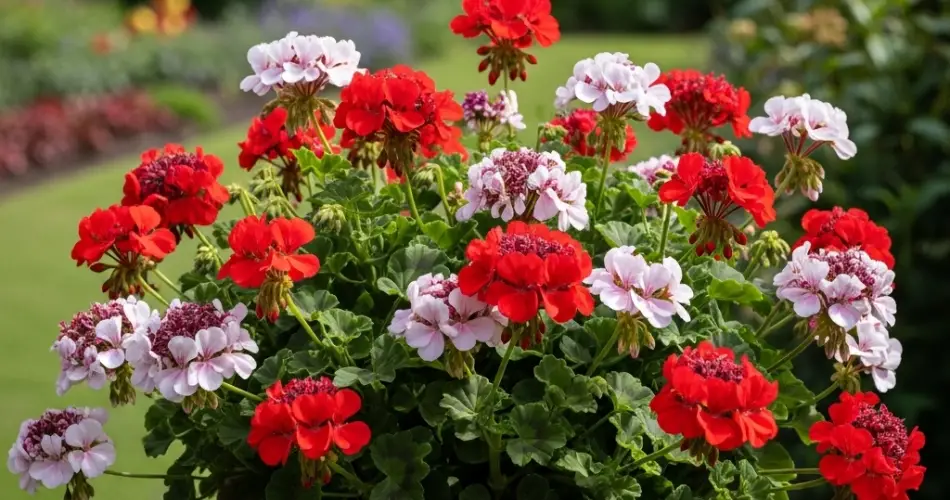Geraniums are a classic garden favorite that bring a cheerful splash of color to patios, balconies, and flower beds. Known for their brilliant blooms and fragrant foliage, geraniums are easy to grow, require minimal care, and are incredibly versatile. Whether grown in pots, hanging baskets, or directly in garden beds, these plants can bloom continuously throughout the growing season when given the right conditions.
Here’s a complete guide to help you grow healthy, blooming geraniums that add vibrant charm to your patio.
1. Choose the Right Geranium Variety
There are several types of geraniums, each with unique qualities. The most popular patio types include:
Zonal Geraniums (Pelargonium x hortorum): These have upright growth, strong stems, and large flower clusters—ideal for containers and garden beds.
Ivy Geraniums (Pelargonium peltatum): Known for their trailing habit, they are perfect for hanging baskets or window boxes.
Scented Geraniums: Grown primarily for their fragrant leaves, which come in scents like rose, lemon, and mint. They also produce small, pretty blooms.
Regal or Martha Washington Geraniums: These offer large, showy flowers and do best in cooler temperatures.
For patios, zonal and ivy geraniums are typically the best options due to their long bloom time and showy flowers.
2. Provide Plenty of Sunlight
Geraniums are sun-loving plants that bloom best in full sunlight.
Aim for at least 6 hours of direct sun each day.
In very hot climates, a bit of afternoon shade can prevent leaf scorching.
If growing indoors or in a shaded patio, choose the sunniest possible spot near a window or move the containers outdoors during peak daylight hours.
Without sufficient sunlight, geraniums may grow leggy and produce few blooms.
3. Use Well-Draining Soil
Geraniums dislike soggy soil and can quickly suffer from root rot if drainage is poor.
Use a light, well-draining potting mix formulated for container plants.
Add perlite or coarse sand to improve drainage if needed.
If planting in the ground, ensure the soil is loose and not clay-heavy. Amend garden soil with compost or organic matter to promote airflow and nutrient availability.
Good drainage is especially important for container-grown plants.
4. Watering the Right Way
Geraniums prefer a moderate watering schedule.
Water deeply, then allow the top inch of soil to dry out before watering again.
Avoid overhead watering—soak the soil at the base to keep foliage dry and prevent fungal issues.
In hot weather, containers may need watering every day, but always check the soil first to avoid overwatering.
During cooler months or periods of reduced sunlight, reduce watering frequency.
5. Fertilize for Strong Growth and Flowers
To keep geraniums blooming all season, they need regular feeding.
Use a balanced, water-soluble fertilizer (such as 10-10-10 or 20-20-20) every 2–3 weeks during active growth.
Avoid high-nitrogen fertilizers, which can promote leafy growth at the expense of flowers.
You can also use a slow-release fertilizer at the start of the season for a low-maintenance option.
Regular feeding encourages lush foliage and more frequent blooming.
6. Deadhead and Prune for More Blooms
Deadheading—or removing spent flowers—is crucial to keeping geraniums looking tidy and blooming continuously.
Snip off faded flowers just above a leaf node to encourage new buds.
Regularly trim leggy or overgrown stems to maintain a compact shape.
If your geranium becomes too woody, a more aggressive pruning in early spring can rejuvenate the plant.
Pruning stimulates new growth, which leads to more flower production.
7. Protect from Pests and Disease
While geraniums are relatively pest-resistant, they can occasionally be affected by:
Aphids
Whiteflies
Spider mites
Botrytis (gray mold) if conditions are damp and poorly ventilated
Inspect plants regularly and treat infestations early with insecticidal soap or neem oil. Ensure good air circulation around plants and avoid crowding containers.
8. Overwintering Geraniums
If you live in a colder climate, geraniums won’t survive a hard frost, but they can be overwintered indoors.
Before frost, bring potted geraniums inside and place them in a sunny window.
Reduce watering and stop fertilizing while the plant is semi-dormant.
Alternatively, take cuttings in late summer, root them indoors, and plant them out again the following spring.
Overwintering helps you keep your favorite varieties year after year without having to buy new plants.
9. Design Tips for Patio Displays
